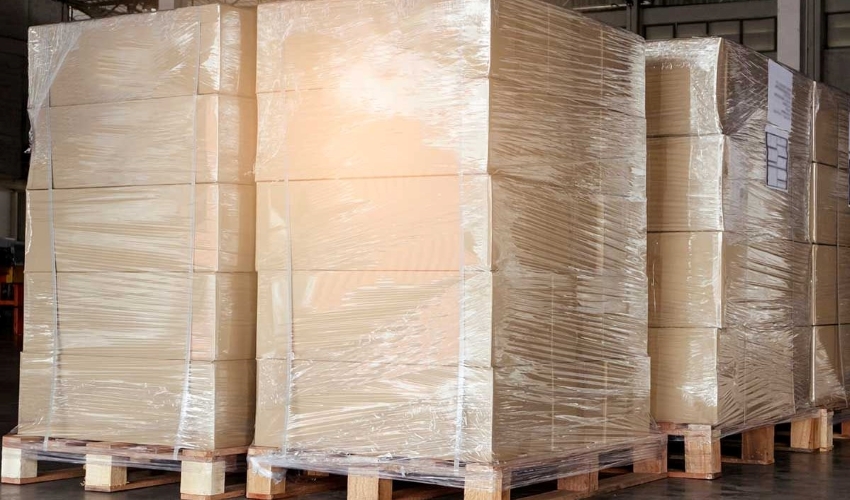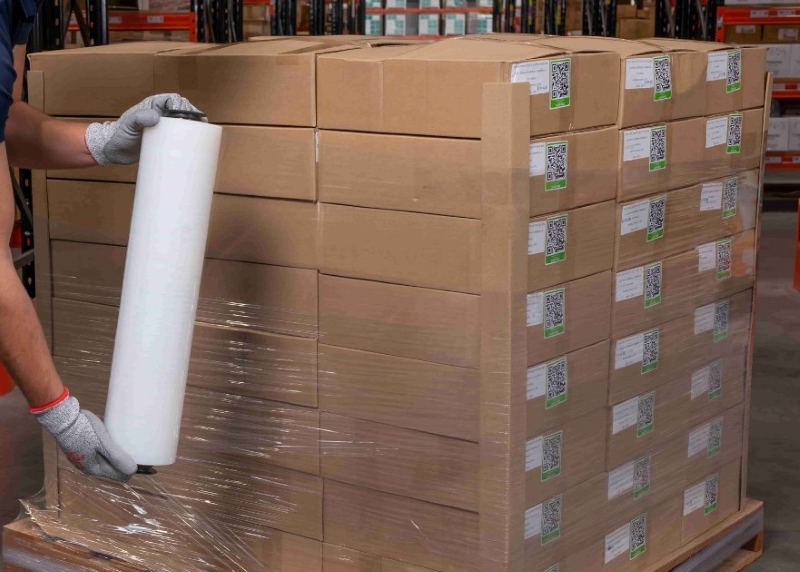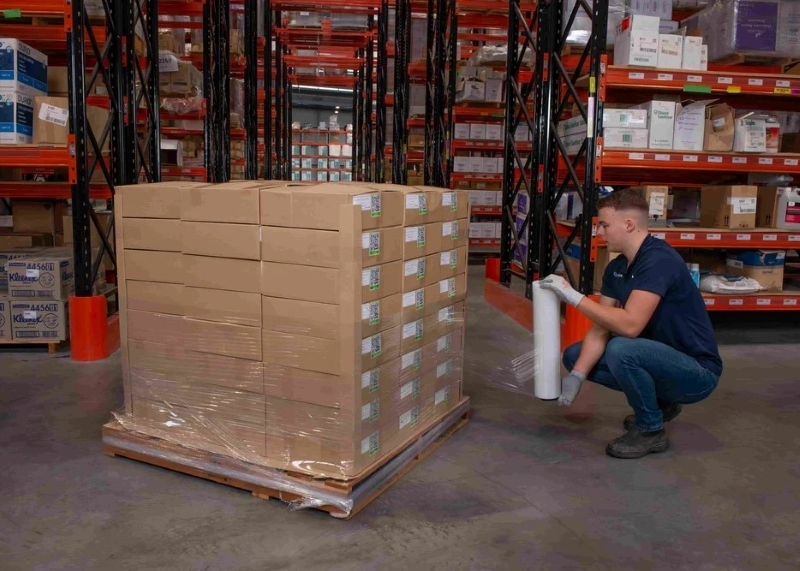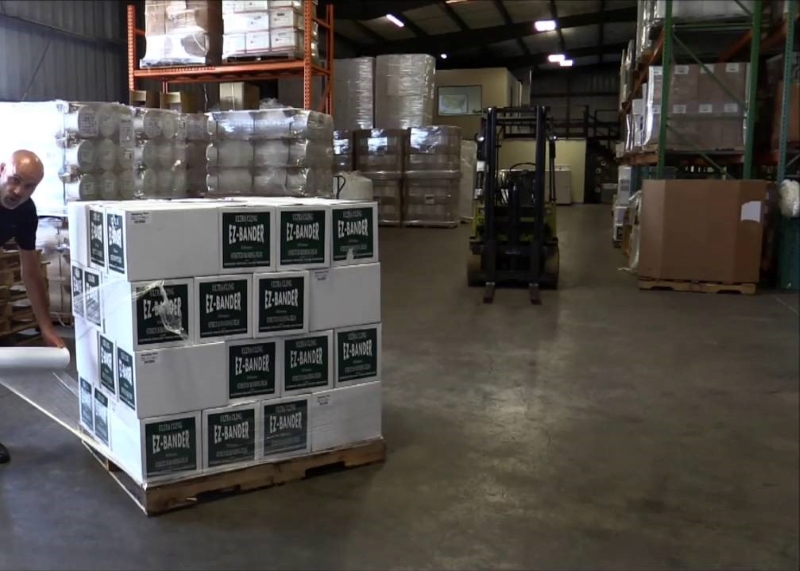
Pallet wrapping is an essential process in logistics and warehousing, playing a critical role in ensuring the safe transportation and storage of goods. By securely stabilizing loads on pallets, wrapping helps prevent damage during handling, shipping, and storage. However, improper wrapping can lead to accidents, product damage, and increased costs. Adhering to pallet wrapping standards is crucial for maintaining safety and stability across all stages of logistics. These standards provide specific guidelines for wrap application, load security, and equipment safety, reducing risks to both inventory and personnel. Brands like PWP Stretch Film offer solutions that align with these standards, helping companies optimize pallet wrapping procedures and minimize workplace hazards. Pallet wrapping standards ensure safety with 2-3 low and high wraps, proper tension, overlap, coverage, secured ends, and suitable wrap type.
Pallet wrapping is a crucial step in ensuring the safe transportation and storage of goods, particularly in logistics and warehousing operations. Adhering to established pallet wrapping standards enhances load stability, minimizes risks during transit, and optimizes material usage. These standards encompass various aspects such as the number of wraps, coverage, tension, and proper handling of wrap ends, each tailored to specific load characteristics. Additionally, the use of appropriate wrapping machines and materials, such as UV-resistant films, ensures durability and compliance with operational requirements. A detailed understanding of these standards is essential for maintaining efficiency and safety across the supply chain.

The number of wraps required depends on the load’s weight, size, and shape. Light and uniform loads typically need 2–3 wraps to stabilize them securely. For heavier, taller, or irregularly shaped loads, an additional 1–2 wraps may be necessary, especially at high-stress points such as corners or the top edges of the load. Over-wrapping should be avoided as it can lead to unnecessary material waste and higher costs.
Proper coverage ensures the load is fully secured and anchored to the pallet frame. The wrap should extend to cover the entire top surface, particularly for loads that are uneven or stacked high. Additionally, the bottom layers of the wrap must connect the goods tightly to the pallet to prevent shifting during transportation. Coverage should be uniform to avoid creating weak points that could compromise stability.
Applying the correct tension is essential to maintain load stability without damaging the goods. The ideal tension depends on the load’s characteristics. For lightweight or delicate items, lower tension prevents deformation or crushing. In contrast, heavy or dense loads require higher tension to withstand movement during handling. Tensioning devices or pallet wrapping machines can help achieve consistent and optimal tension.
Loose or unsecured wrap ends can cause safety hazards, such as tripping or catching in automated systems. Properly securing the ends of the wrap, either by tucking them into the wrapped layers or sealing them with a heat gun, ensures they remain tight and do not unravel during handling or transport. Secured ends also enhance the overall aesthetic and professionalism of the wrapped pallet.
Achieving a 50% overlap between each pass of the wrap ensures even coverage and adds strength to the layers. This overlap is particularly important for irregularly shaped or stacked loads, as it provides consistent tension and minimizes the risk of gaps or exposed areas. Overlapping also helps distribute the wrap’s load-bearing capacity evenly across the pallet.
Pallet wrapping machines automate the process, improving efficiency and consistency. These machines are particularly useful for high-volume operations where speed and uniformity are critical. They apply precise tension, ensure consistent overlap, and reduce material waste. Advanced machines can also accommodate various load sizes and apply specialized wraps, such as pre-stretched film or UV-resistant materials.
The choice of wrap depends on specific operational needs. For example, UVI (Ultraviolet Inhibitor) stretch wrap is ideal for outdoor storage, protecting goods from UV radiation that can cause discoloration or material degradation. High-performance wraps, such as pre-stretched or reinforced films, are used for heavy or sharp-edged loads. Transparent wraps allow easy identification of goods, while colored or opaque wraps provide privacy and protection against theft.
These detailed standards ensure that pallet wrapping not only secures goods effectively but also enhances operational efficiency, safety, and durability during transportation and storage.
Pallet wrapping standards are critical for maintaining load stability, worker safety, and the efficiency of warehouse operations. These standards provide clear guidelines on proper wrapping techniques, load balancing, and safety procedures. By following these guidelines, companies can reduce the risk of accidents and ensure that wrapped loads remain stable during transit and storage. Accessing a pallet wrapping standards PDF offers an easy way to review and reference these protocols.
Pallet wrapping standards PDF documents are typically available through industry associations, safety organizations, and reputable packaging suppliers like PWP Stretch Film. These resources can be found:
Pallet wrapping standards PDF guides often include comprehensive information on the following:
By following the instructions in these pallet wrapping standards PDFs, companies can create safer, more efficient workflows that support the stability of their pallets and the protection of their workforce.
To ensure a safe and effective working environment, OSHA provides clear guidelines for pallet wrapping standards. These standards are designed to reduce workplace injuries, enhance load stability, and promote consistent wrapping techniques. By following OSHA guidelines, warehouses and logistics companies can minimize the risks of handling and transporting unstable loads, ultimately fostering a safer workspace.

OSHA’s requirements for pallet wrapping standards focus on maintaining worker safety and load stability. These standards address both manual and machine-assisted wrapping processes, ensuring that companies adhere to best practices for load security and injury prevention.
Key OSHA requirements for pallet wrapping standards include:
In addition to equipment and procedures, OSHA’s guidelines for pallet wrapping standards highlight several safe practices for handling various load types, stabilizing loads effectively, and preventing common wrapping injuries. In particular, understanding the most common pallet wrapping injuries is essential to mitigate the risks associated with this process. These injuries typically arise from improper handling of the stretch film, repetitive motions, or inadequate lifting techniques. Below are some of the critical points addressed:
Adhering to OSHA’s pallet wrapping standards offers several advantages that enhance warehouse safety and productivity. By following these guidelines, companies can achieve the following:
To maintain a safe workplace and achieve optimal load stability, companies should incorporate these best practices into their pallet wrapping processes:
Following OSHA’s guidelines for pallet wrapping standards not only ensures a safer work environment but also contributes to the reliability and security of shipped goods. By implementing these practices, companies can safeguard their workforce, protect inventory, and build a culture of safety and compliance in their operations.
Accessing free resources for pallet wrapping standards provides companies with valuable information to enhance load stability, ensure safety, and comply with industry regulations. Such resources are widely available through industry bodies, equipment manufacturers, and packaging solution providers like PWP Stretch Film. Utilizing these free guidelines allows businesses to align with best practices, improve operational efficiency, and maintain compliance with essential safety standards without incurring extra costs.
Free resources for pallet wrapping standards can be found from various reputable sources, each offering insights tailored to specific operational needs and safety guidelines:
Implementing pallet wrapping standards not only enhances safety but also improves operational efficiency, reducing errors and creating a smoother workflow. The benefits of using free resources to adhere to pallet wrapping standards are numerous:
Leveraging free resources for pallet wrapping standards comes with significant advantages for both small businesses and large operations:
Most free resources on pallet wrapping standards include guidelines that address critical areas of pallet wrapping, such as:
Using these free guidelines allows companies to streamline processes, meet compliance requirements, and promote workplace safety, leading to several practical benefits:
Free pallet wrapping standards resources provide essential guidelines that support efficient, safe, and compliant wrapping practices. By incorporating these resources, companies can create a structured approach to load stabilization, reduce workplace injuries, and enhance overall operational performance. Free resources make it easy for companies to adopt industry best practices without additional costs, empowering them to meet safety standards while maintaining high productivity levels. Access to these free guidelines through PWP Stretch Film and other reputable sources enables companies to implement effective pallet wrapping standards across their operations, leading to a safer and more efficient workplace.
Stretch wrap machines are valuable tools in warehousing and logistics, significantly improving efficiency, consistency, and load stability when wrapping pallets. To ensure safe operation, adherence to stretch wrap machine safety guidelines is essential, as these practices align with pallet wrapping standards designed to protect workers and optimize load security. Using stretch wrap machines properly not only enhances safety but also helps reduce material waste and maintain compliance with industry regulations.
Operating stretch wrap machines safely involves a combination of proper training, clear protocols, and adherence to established guidelines for pallet wrapping standards. Key best practices to follow include:
Operator Training and Familiarization
Operators should undergo thorough training before using stretch wrap machines, ensuring they understand machine functions, safety features, and emergency stop mechanisms. Training should include:
Work Area Safety and Machine Positioning
For optimal safety, the stretch wrap machine should be placed in a well-organized, clear area that minimizes the risk of accidents. Key considerations for positioning and maintaining a safe workspace include:
Pinch Point Awareness and Guarding
Pinch points—where machine parts move and could cause injury—are a significant concern with stretch wrap machines. To ensure operator safety, it’s important to:
Regular Machine Maintenance and Inspection
Routine maintenance and inspection are essential to keep stretch wrap machines in safe working condition. Key steps include:
Setting the correct machine parameters is critical for achieving the best results while adhering to pallet wrapping standards. Proper machine settings not only improve load stability but also ensure compliance with safety and material usage guidelines. The following tips can help optimize machine parameters:
Adjusting Wrap Tension and Pre-Stretch
Wrap tension and pre-stretch are crucial for creating a secure, stable wrap. Correctly adjusted tension prevents over-tightening, which can damage products, and under-tightening, which can lead to unstable loads. Recommendations include:
Setting Wrap Overlap and Wrap Layers
Proper overlap and the number of wrap layers ensure that each section of the load is secured uniformly. Recommended guidelines for overlap and layers include:
Controlling Wrap Speed and Film Delivery Rate
The speed at which wrap is applied and the film delivery rate can affect the quality of the wrap and the safety of the operator. Best practices for these settings include:
Monitoring Temperature and Environmental Factors
Environmental factors such as temperature can impact stretch wrap elasticity and machine performance. To address these factors, consider:
Complying with stretch wrap machine safety guidelines aligned with pallet wrapping standards offers several advantages for operations and employee safety, including:
Following stretch wrap machine safety guidelines for pallet wrapping standards is essential for promoting a safe and efficient work environment. By adhering to best practices for machine operation, setting optimal parameters, and conducting routine inspections, companies can enhance load stability, reduce material waste, and protect employees. Using equipment from trusted providers like PWP Stretch Film ensures that companies can achieve high standards in pallet wrapping while maintaining compliance with essential safety protocols.
In pallet wrapping operations, machine guarding is a crucial aspect of safety, essential to protecting workers from hazards associated with automated wrapping equipment. Guarding measures for pallet wrappers, as outlined in pallet wrapping standards, are specifically designed to reduce risks related to moving parts, pinch points, and accidental machine activation. For businesses utilizing entry level pallet wrapping solutions, proper guarding is still a critical consideration, ensuring safety even with less advanced machinery. Proper guarding not only enhances operator safety but also aligns with regulatory requirements, ensuring companies remain compliant with safety standards.

Machine guarding is an integral part of pallet wrapping standards, safeguarding employees who work closely with wrapping machines. These standards prioritize worker safety by minimizing direct exposure to machine mechanisms that can cause injuries if not properly protected. Effective guarding can prevent various types of injuries, including hand, arm, and finger injuries, commonly associated with pinch points in machine operation.
The benefits of maintaining proper machine guarding as per pallet wrapping standards include:
The Occupational Safety and Health Administration (OSHA) provides detailed guidelines regarding guarding requirements for machines, specifically addressing pinch points, which are areas where parts move together and pose risks of crushing or pinching injuries. In the context of pallet wrapping standards, OSHA mandates that employers install guarding mechanisms on wrapping machines to shield workers from these hazardous areas.
To comply with OSHA’s guarding standards, pallet wrapping machines must incorporate several key features:
Proper installation of machine guards is critical to ensuring they provide adequate protection. Following these best practices will help companies meet the requirements for pallet wrapping standards:
Meeting guarding requirements as outlined in pallet wrapping standards brings several advantages that contribute to a safer and more efficient operation:
Implementing pallet wrapper guarding in line with pallet wrapping standards is a vital component of workplace safety in any warehouse or logistics setting. Guarding protects workers from hazards associated with pinch points and moving parts, while also helping companies adhere to OSHA requirements. By assessing risk points, securing guards effectively, and conducting regular inspections, companies can provide a safer working environment, reduce injuries, and maintain compliance with essential safety standards. With equipment from trusted providers like PWP Stretch Film, companies can ensure they are meeting the highest standards in pallet wrapping safety and machine guarding.
Adhering to pallet wrapping standards and best practices ensures load stability, improves workplace safety, and maximizes material efficiency. Proper pallet wrapping, whether done manually or by machine, prevents product damage during handling and transit while meeting compliance requirements. Both manual and machine-wrapping techniques have specific applications and approaches to achieve effective load stabilization. Furthermore, different load types require tailored wrapping methods to maintain consistency with pallet wrapping standards.
Applying effective wrapping techniques is essential for stabilizing loads, securing inventory, and ensuring compliance with pallet wrapping standards. Here are best practices for both manual and machine wrapping methods:
Manual wrapping is ideal for low-volume operations, smaller warehouses, or irregular loads. Following these techniques helps ensure the stability of manually wrapped pallets:
Machine wrapping is ideal for high-volume operations, as it increases efficiency and consistency. Machine settings must align with pallet wrapping standards to ensure safety and minimize material waste:
Different load configurations require tailored wrapping techniques to meet pallet wrapping standards. Applying the right approach for each load type enhances stability and prevents damage:
Uniform loads consist of items of similar shape, size, and weight, such as stacked boxes or evenly packed containers. Recommendations for uniform loads include:
Irregular loads include items of varying shapes and sizes, which require careful wrapping to secure loose or uneven edges. Techniques include:
Mixed loads consist of items of different weights and sizes on a single pallet. These loads require balanced wrapping techniques to maintain stability:
Fragile loads, such as glass, electronics, or other delicate items, require careful handling and wrapping to prevent damage:
Following pallet wrapping standards and implementing best practices yield multiple operational benefits, including:
Pallet wrapping standards and best practices are essential for safe, stable, and efficient load management in warehouses and logistics settings. By applying techniques tailored to both manual and machine wrapping, and considering specific wrapping needs for different load types, companies can achieve consistent load security while minimizing waste. With tools and materials like those from PWP Stretch Film, adhering to pallet wrapping standards becomes a streamlined process, supporting a safer work environment and delivering secure products to their destinations.
OSHA (Occupational Safety and Health Administration) has specific guidelines for pallet usage in workplaces to ensure worker safety and reduce the risk of accidents during handling and storage. Key OSHA standards for pallets emphasize safe stacking, proper inspection, and general handling practices. For example, OSHA mandates that pallets be regularly inspected for signs of damage, such as broken boards, loose nails, or splinters, before use. Damaged pallets should not be used and must be removed from service immediately to prevent load instability.
In terms of stacking, OSHA suggests pallets should be stacked at a safe height, typically no higher than 15 feet, although this can vary depending on the goods being stored and the specific workplace setup. Pallets should also be stacked evenly, with the heaviest loads on the bottom to create a stable base. Additionally, OSHA recommends keeping pallets clear of high-traffic areas to minimize the chance of collisions or accidents. By following these OSHA standards, workplaces can enhance pallet safety, prevent product loss, and maintain a safer environment for employees.
The number of wraps a pallet needs depends on factors like load type, stability requirements, and whether manual or machine wrapping is used. Generally, a pallet should be wrapped between 3 to 5 times at the base to secure the load to the pallet. This base wrapping creates a strong foundation, preventing the load from shifting during handling and transit. As the wrapping progresses up the pallet, it’s recommended to overlap each layer by about 50%, maintaining even tension to ensure stability across the entire load. For heavier or more fragile loads, additional wraps may be required around the corners and top of the load to prevent any movement during transport.
Machine wrapping is more precise and often involves pre-stretch technology, which extends the wrap’s elasticity and secures the load effectively with fewer layers. Hand wrapping, while more flexible for custom loads, may require additional wraps to achieve the same level of security. In general, machine wrapping typically requires fewer layers due to consistent tension and coverage. However, for both methods, securing the load firmly and ensuring it doesn’t shift or become unbalanced is the primary goal.
Pallet wrapping involves the application of stretch film or shrink wrap around goods stacked on a pallet to secure them during storage or transport. The primary specifications include the type of wrap (e.g., hand-applied or machine-applied stretch wrap), film thickness (typically 17–23 microns), and stretchability (standard films can stretch up to 300%). Proper tension is critical to avoid damaging goods while ensuring stability. Wrapping patterns, like spiral or cross-wrap, depend on the load’s weight and dimensions. Additionally, pallets often require edge protectors and slip sheets to prevent tearing. Specific regulations or customer requirements may mandate the use of UV-resistant or colored films for outdoor storage or identification purposes.
To correctly wrap a pallet, start by ensuring the load is stable and evenly stacked. Begin by anchoring the wrap at the pallet’s base, typically wrapping it around twice to secure the film. Gradually move upward, overlapping each layer of film by at least 50% to ensure full coverage. Once you reach the top, wrap horizontally to secure the upper edges, and then work your way back down for added reinforcement. Maintain consistent tension to keep the wrap tight without tearing. Ensure the film covers all edges, including the pallet itself, to stabilize the load and prevent shifting during transit. Always inspect for gaps or loose ends before finishing.
Unmarked pallets, especially those not bearing identification like heat-treatment (HT) or fumigation marks, may not meet safety or regulatory standards. Such pallets could be untreated and prone to infestation, compromising goods during international shipping. Additionally, unmarked pallets may lack sufficient structural integrity, increasing the risk of breakage under heavy loads. For food-grade or pharmaceutical applications, unmarked pallets may pose contamination risks. Always verify the origin and material of unmarked pallets before use. Opting for certified pallets with clear markings ensures compliance with ISPM 15 standards and enhances safety and reliability.
The amount of shrink wrap required depends on the pallet size, load height, and type of goods. Typically, a standard roll of stretch wrap (1500–2000 feet) can wrap 20–30 pallets. For a standard 48×40-inch pallet stacked to 5 feet, you may need 100–150 feet of wrap for optimal coverage. Factors such as load type (e.g., irregular shapes or sharp edges) and the chosen wrapping method (hand or machine) can also impact usage. Using thicker films or reinforcing high-stress areas may increase the required amount. Monitoring wrap usage per pallet can help control costs while ensuring load stability.
Begin by securing the load and ensuring the pallet is level. Start wrapping at the base to anchor the load. Use a consistent technique, applying tension evenly to avoid sagging or tearing the wrap. Overlap each layer by at least 50%, ensuring no gaps. Wrap from the base upward, including the pallet corners and edges, for stability. For tall loads, use vertical or diagonal reinforcement wraps to prevent tipping. Inspect the finished pallet to confirm the film is tight, with no loose ends. Use edge protectors for sharp or fragile items to avoid punctures. Proper wrapping ensures a secure and transport-ready pallet.
Standard pallet sizes vary by region. In North America, the most common size is 48×40 inches, commonly used in general industries. Europe typically uses the 1200×800 mm Euro pallet. In Asia, sizes like 1100×1100 mm or 1200×1000 mm are standard for logistics and export. Standard sizes ensure compatibility with warehouse systems, transportation equipment, and packaging regulations. The size you choose depends on the nature of goods, shipping requirements, and compatibility with supply chain infrastructure. Adhering to standard sizes minimizes logistical challenges and ensures seamless operations across regions.
The time needed to wrap a pallet depends on the wrapping method and the operator’s expertise. Hand wrapping typically takes 2–5 minutes per pallet, depending on the load’s complexity and height. Machine wrapping, using semi-automatic or automatic stretch wrappers, can significantly reduce the time to 1–2 minutes. Factors like load size, film type, and wrapping technique (e.g., number of layers) also influence the duration. Training workers in efficient hand-wrapping methods and using well-maintained equipment ensures quicker turnaround times without compromising wrap quality.
To avoid dizziness when wrapping a pallet by hand, focus on using controlled, deliberate movements. Anchor the wrap securely to the pallet base, then walk slowly around the pallet, keeping your head steady and avoiding rapid spinning. Consider turning the pallet on a turntable if available or switching to a semi-automatic stretch wrapper to minimize repetitive movement. Alternate between moving the wrap upward and downward to vary your motion. Staying hydrated, taking regular breaks, and ensuring good lighting can also help reduce dizziness during the wrapping process.

My name is James Thompson, and I’m the editor of this website dedicated to Stretch Film, Pallet Wrap, and Stretch Wrap products.
My passion for packaging began when I noticed the challenges companies face in securing their products efficiently for transportation and storage. This inspired me to delve deep into the world of stretch films and pallet wraps, exploring the latest technologies and best practices.
I aim to provide valuable insights, practical tips, and up-to-date industry trends to assist you in making informed decisions. Whether you’re a small business owner or part of a large corporation, my goal is to support you in optimizing your operations and ensuring your products reach their destination safely.
Thank you for visiting, and I look forward to accompanying you on your journey toward better packaging solutions.
Comments are closed